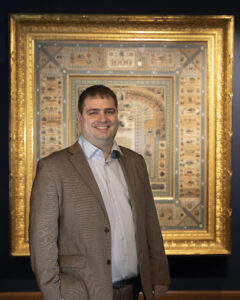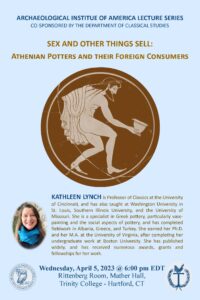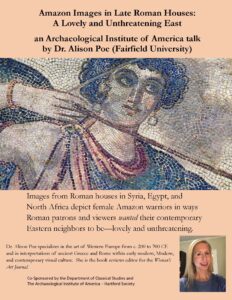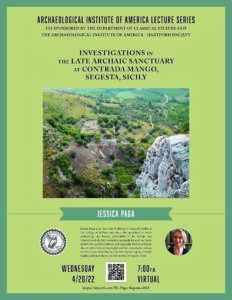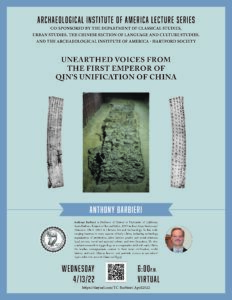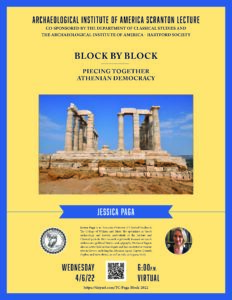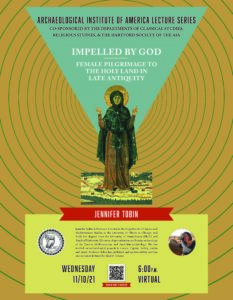AIA Lecture Series
Four times per year, Trinity's Classical Studies Department hosts events of the Archaeological Institute of America (AIA) Hartford Society.
| Thursday, November 13, 2025 at 5:00pm – Rittenberg Lounge, Mather Hall , Trinity College Campus
The Rape of the Sabines: Myth and History in the Urban Development of Republican Rome Abstract: This lecture analyzes how the legendary story of the “Rape of the Sabines” was used to construct a network of sacred sites conveying the value of feminine virtue across Rome’s eastern hills in the Republican period. It presents the archaeological and historical evidence for each of the sites and argues that they all pertained to a different aspect of the female lifecycle with respect to marriage and reproduction. The sites would have been linked to each other and to the narrative of the “Rape of the Sabines” during the early third century BCE, when M’. Curius Dentatus triumphed over these peoples. This was a period when Rome’s eastern hills were experiencing rapid population growth and urban development, as indicated by Dentatus’ subsequent construction of the Aqua Anio here. I argue that Dentatus and other residents of this area used the “Rape of the Sabines” and the network of female shrines to incorporate this part of the growing city and the newly-conquered Sabines into Rome’s mythological past. This moment in Rome’s development demonstrates the active role that Rome’s residents played in shaping not only the physical expansion of this area of the city but also its significance in Rome’s past and present. Co-sponsored by the AIA-Hartford Chapter and the Department of Classical Studies, Trinity College
|
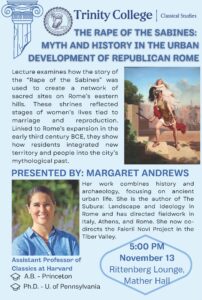 |
|
| Wednesday, February 26, 2025 at 6:00pm – Rittenberg Lounge, Mather Hall , Trinity College Campus
On Perseverance: Virtually Unwrapping the Herculaneum Scrolls Abstract: Co-sponsored by the AIA-Hartford Chapter and the Department of Classical Studies, Trinity College |
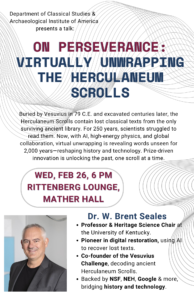 |
|
| Wednesday, October 9, 2024 at 6:00pm – Rittenberg Lounge, Mather Hall , Trinity College Campus
Towards an Archaeology of Cult in a Greek Colony in the West: New Excavations in the Main Urban Sanctuary of Selinunte Abstract: Co-sponsored by the AIA-Hartford Chapter and the Department of Classical Studies, Trinity College |
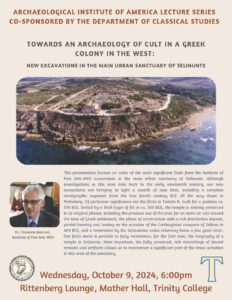 |
|
| Thursday, October 17, 2024 at 6:00pm – Rittenberg Lounge, Mather Hall , Trinity College Campus
1177 BC and After: The Collapse and Survival of Civilizations Abstract: While the centuries following the Late Bronze Age Collapse in the Aegean and Eastern Mediterranean were a time of catastrophe, they were also a time of rebirth and resilience — it was less of a Dark Age and more of a reboot for many of the societies which were affected. While there are examples of failure to thrive or even to survive in some cases, others managed to adapt and transform. In effect, we have eight case studies of what to do (and what not to do) in the event of a systems collapse, ranging from the Assyrians to the Egyptians to the Mycenaeans and others in between. We will focus on the people and places that emerged from the ashes, highlighting some of the events and developments that took place in Greece, Egypt, Mesopotamia, Anatolia, and the Levant. We will also consider whether there are any relevant lessons to be learned from this dramatic story of resurgence and revival, especially considering what is going on in our world today. Co-sponsored by the AIA-Hartford Chapter and the Department of Classical Studies, Trinity College |
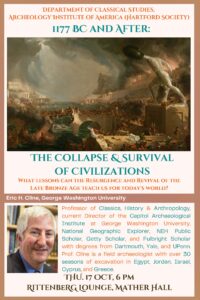 |
|
| Wednesday, October 25, 2023 at 6:00pm – Rittenberg Lounge, Mather Hall , Trinity College Campus
Big Data, Small Coins: The First Two Centuries Monetizing the Roman Frontier Abstract: In this presentation I employ big data and a macro-regional perspective to assess coin finds from the Rhine frontier in order to reconsider the impact and role of the military on the development of monetary economy during the first two centuries. An often argued and imposed connection between Roman conquest and immediate and widespread coin adoption and monetization is challenged. Co-sponsored by the AIA-Hartford Chapter and the Department of Classical Studies, Trinity College |
|
|
| Wednesday, April 5, 2023 at 6:00pm – Rittenberg Lounge, Mather Hall , Trinity College Campus
Sex and Other Things Sell: Athenian Potters and their Foreign Consumers Abstract: This lecture will explore how the foreign market for Athenian vases impacted production choices of the Athenian potters. In order to provide a vivid example of the problem, we will first examine erotic images of heterosexual couples on Athenian black-figure and red-figure vases produced from about 525-450 B.C. While these pots are certainly made in Athens, they are found only in Etruria. We will consider why the Athenians marketed these images to the Etruscans, and in turn why the Etruscans may have appreciated them. No clear answers exist, but considering intention and reception of the images does underscore that the Athenian potters were businessmen who aimed to sell pots. In order to understand how the export market differed from the domestic pottery market, we will also examine pottery found in genuine Athenian houses. It turns out that pottery used by Athenians had simple, “genre” scenes. There is no sign of heterosexual intercourse and very few examples of mythological scenes. Finally, we will review some famous Athenian vases that were found in Italy, mainly in Etruscan tombs. It seems that the Etruscan consumers wanted Athenian pottery with suitably “Greek” decoration, a kind of “Hellenisme” to which the Athenian potters responded by producing vases with culturally characteristic scenes. The erotic scenes and complex mythological scenes may have sold because they reflected Etruscan impressions of the Athenians. Parallels for a complex relationship between the producer and the consumer will be sought in the production of Chinese porcelain for Europeans and sexualized postcard images of Arab women produced for French colonizers. NB: Lecture will contain vase painting images of explicit sexual scenes. Co-sponsored by the AIA-Hartford Chapter and the Department of Classical Studies, Trinity College |
|
|
| Tuesday, October, 18, 2022 at 6:00pm – McCook Auditorium, Trinity College Campus (Masks are required)
Amazon Images in Late Roman Houses: A Lovely and Unthreatening East Abstract: This study is the first to consider the meanings and purposes of Amazon images from c. 400 to c. 650 CE. The surviving examples consist of mosaics, textiles, and a silver plate that decorated (or likely came from) Roman houses in Syria, Egypt, and North Africa. These images depict well-coiffed, heavily bejeweled Amazons on leisurely hunts atop elaborately groomed horses or dancing in religious rituals. The scenes emphasize that the Amazons come from the East: the women wear tall, floppy caps, which are depicted in Roman art on the Magi and other Easterners; they hunt leopards and lions; and they take the very difficult rear-facing archery shot associated by the Greeks and Romans with the Parthians of ancient Iran. This paper argues that the imagery presents the Amazons the way Roman patrons and viewers wanted their contemporary Eastern neighbors to be—lovely and unthreatening. The scenes form part of the “good life” imagery that proliferated in late Roman houses, surrounding homeowners and their guests with the world they wished to see. Instead of Rome’s actual eastern neighbor, the powerful Sasanid Persian empire, which posed a very real threat to Roman peace, the tamed mythical Amazons in these images constructed an idealized East to calm the fears of Romans living in the regions most at risk. Co-sponsored by the AIA-Hartford Chapter and the Department of Classical Studies, Trinity College |
||
| Wednesday, April 20, 2022, 7pm – Virtual Lecture
Investigations in the Late Archaic Sanctuary at Contrada Mango, Segesta, Sicily Abstract: Tucked into the remote side of a towering mountain on the western coast of Sicily sits a sanctuary that has the potential to bring a mysterious civilization to light. The Elymians were an indigenous group of people living in what is today the Trapani district during the 8th to 2nd c. B.C.E. One of their principal cities was Segesta, famous for embroiling the Athenians in their misguided Sicilian Expedition. Today, the site is frequently admired for its stunning theater and well-preserved (but unfinished) temple. Less well-known is the older, Archaic sanctuary, located on the opposite side of the mountain. Over the course of two summers, a small research team has documented over 200 blocks of a monumental sanctuary and investigated how it marries Elymian and Greek archaeological components, hinting at a complex relationship between a local population and their new colonizing neighbors, made manifest in shared ritual practice. Co-sponsored by the AIA-Hartford Chapter and the Department of Classical Studies, Trinity College |
||
| Wednesday, April 13, 2022 6pm – Virtual Lecture
Unearthed Voices from the First Emperor of Qin’s Unification of China Abstract: This lecture takes us back to the late 3rd century BCE in China, to experience the momentous creation of the first empire in East Asia, as seen through excavated documents and tombs. These restore some of the voices of those silenced by the ravages of time and by the biased editing of ancient historians. The lecture is divided thematically into “voices of the state” and “voices of the people.” For the voices of state actors, we hear an announcement from a governor in recently-conquered territory in the south which informs us that the Qin were determined to stamp out “deviant” religious practices and sexual habits among its new subjects; a scribe’s aide-memoire, thrown in a well at the end of the dynasty, tells of Qin attempts to control language after the unification; an ordinance promulgated by the First Emperor calls for conserving peasant agricultural labor; and an edict of the Second Emperor of Qin displays surprising sympathy for his subjects. For the voices of commoners and soldiers caught up in these events, we hear legal cases from the time just before and after the unification that narrate the difficult lives and legal plight of those ensnared by the Qin laws. A state musician appeals his wrongful conviction for cattle rustling and tries to free his impounded family; a destitute Qin army veteran confesses to a brazen assault and robbery in the capital; and a woman denounces herself for engaging in a street brawl that led to a miscarriage. We shall also hear touching letters from Qin soldiers that give poignant voice to the concern of two young men for their friends and relatives back home. And finally, we will hear the voices of the fallen victims to the Qin conquest, see through the mass graves of soldiers, exposing the enormity and horror of war.
Co-sponsored by the AIA-Hartford Chapter, the Department of Classical Studies, The Chinese Section of Language and Culture Studies & Urban Studies, Trinity College |
|
|
| Wednesday, April 6, 2022, 6pm – Virtual Lecture
Block by Block: Piecing Together Athenian Democracy Abstract: In 508/7 B.C.E., after years of stasis and uncertainty, the city of Athens was rocked by a momentous occurrence: the passage of a series of reforms that resulted in the creation of what has come to be known as the world’s first democracy. Exactly how the Athenians did this is still a fundamental question 2,500 years later. The reforms transformed the very nature of what it meant to be Athenian and their far-reaching effects would come to leave their mark on nearly every aspect of society, including the structures at which they prayed and in which they debated legislation. This lecture investigates the built environment of ancient Athens precisely during this time, the Late Archaic period (ca. 514/13 – 480/79 B.C.E.). It was these decades, filled with transition and disorder, when the Athenians transformed their political system from a tyranny to a democracy. Concurrent with the socio-political changes, they altered the physical landscape and undertook the monumental articulation of the city and countryside. Interpreting the nature of the fledgling democracy from a material standpoint, this lecture approaches the questions and problems about the early political system through the lens of buildings. The lecture draws attention to a pivotal period of Athenian political history through the built environment, thereby exposing the richness of the material record and illustrating how it participated in the creation of a new democratic Athenian identity. Co-sponsored by the AIA-Hartford Chapter and the Department of Classical Studies, Trinity College |
|
|
| November 10, 2021 @ 6:00 pm via Zoom Webinar
Impelled by God: Female Pilgrimage to the Holy Land in Late Antiquity Abstract: When Constantine the Great sent his mother Helena to the Holy Land to identify and develop sacred Christian sites, he unwittingly set into action a movement among religious women throughout the Roman Empire. Emulating the queen mother, their goal was to explore their religion by visiting places mentioned in scripture. During the 4th-6th centuries female pilgrims of noble and not so noble birth journeyed to Jerusalem, Egypt and the Levant, exhibiting a kind of mobility that women rarely experienced in prior centuries would not enjoy again until modern times. Perhaps the best known of these adventurers is Egeria, who in the late 4th century CE spent three years traveling through what is now Egypt, Jordan, Syria, Israel, Turkey and the Palestinian Territories. She recounted her experiences in a series of letters that still survive today. This presentation tracks the journey of Egeria, exploring the landscapes and monuments she encountered and investigating the challenges that she and other female explorers confronted. By doing so we have the unique opportunity to observe this pivotal time in history from a female perspective. Click here to view the recording Co-sponsored by the AIA-Hartford Chapter and the Department of Classical Studies, Trinity College |
||
September 29, 20 Royal Purple and Indigo: The Hidden Labor Behind Luxurious Dyes Abstract: Perhaps no other color in history has been so celebrated and so reviled as the color purple. Although it has come to be known as the shade of royalty, the workers who labored to make the mucus-based dye in the Roman Mediterranean were often viewed as lowly and as smelly as the mollusks the harvested. During the later Roman empire, these workers were even subject to state control within a caste-like system that made their jobs hereditary. If we look to the history of another purplish hue, indigo, we see a similar regulation of the labor force — and the very bodies — of those enslaved workers used to produce it in the Antebellum South. From diamonds to coal to Tyrian purple to indigo, the workers who create luxury goods often do not enjoy the same status as their products. This lecture looks at the archaeological and literary evidence for these often-invisible workers in order to reconstruct the lives of ancient dye workers, while also reminding us of the enslaved labor that continues to create the products we use or the buildings we admire even today. Click here to view the recording21 @ 6:00 pm via Zoom Webinar Co-sponsored by the AIA-Hartford Chapter and the Department of Classical Studies, Trinity College |
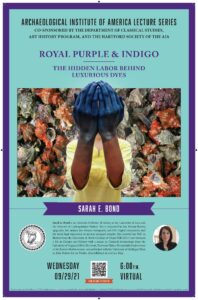 |
|
| April 13, 2021 @ 6:00 pm via Zoom Webinar
The Rise of a Hierarchical Society at Late Bronze Age Mitron Greece, “What Made It Possible?” Aleydis Van de Moortel, University of Tennessee AIA – Hartford Chapter Co-sponsored by the Department of Classical Studies and History. |
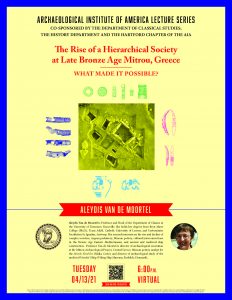 |
|
| March 23, 2021 @ 6:00 pm via Zoom Webinar
Cents in the City – New Coin Finds from a Hellenistic House at Morgantina (Sicily) D. Alex Walthall, University of Texas AIA-Metcalfe Lecture |
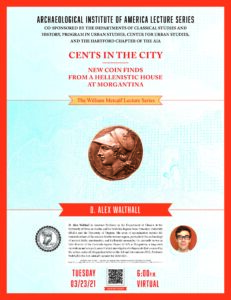 |
|
|
Myth-Ing Sound: Exploring Markers of Music in Ancient Athenian Vase Paintings Danielle Smotherman Bennett A lecture by Danielle Smotherman Bennett, curatorial assistant for the Menil Collection in Houston, Texas. Music features as an important component in a variety of ancient Greek mythological tales, including those portrayed on vases. Athenian vase paintings, however, are a silent medium. This talk demonstrates how images regularly incorporate sound through visual clues inviting viewers to imagine these sensory aspects and how vase painters visually express in different ways music, speech, and other sounds within representations of tales such as Orpheus and Marsyas, among others. Visual markers of sound, such as the inclusion of instruments, figures with an open mouth, and even nonsense inscriptions can entice viewers to relate the depiction with noises an ancient audience would expect. Through engaging the work of scholars and musicians working to recreate ancient Greek music, modern viewers can gain greater insight into the visual representations on ancient ceramics. And can experience how and why ancient Greek artists inspire their audience to fill-in the details of these silent pictures. Co-sponsored by the Departments of Art History, Music and the AIA-Hartford Society |
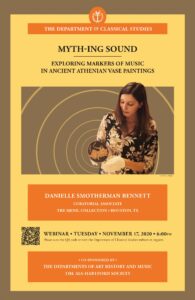 |
|
| October 16, 2019
Of Monsters and Men: The Giants in Greek Visual Art David Wright – Fordham University |
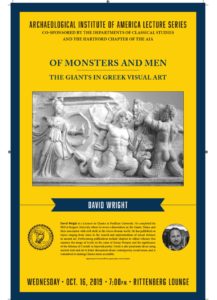 |
|
| September 24, 2019
Sensing the Past: Sensorial Experience in Ancient Mesopotamia Allison Thomason – Southern Illinois University, Edwardsville Co-sponsored by the Departments of Art History and History, and the Program in International Studies |
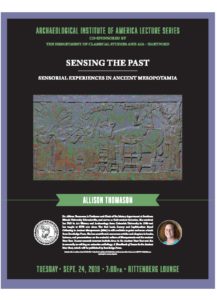 |
|
| April 9, 2019
Altars of Zeus, Games for the Gods: Mt. Lykaion and Olympia in Early Greek Religion David Gilman Romano, Nicholas and Athena Karabots Professor of Greek Archaeology, School of Anthropology, University of Arizona Co-sponsored by Department of Religious Studies |
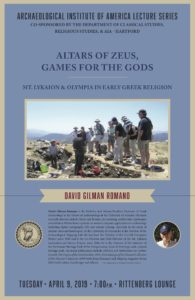 |
|
| March 12, 2019
The Huntress Tamed, The East Subdued Alison Poe, Lecturer in the Art History & Visual Culture program, Co-sponsored by Department of Art History and the Program in Women, Gender & Sexuality |
![[description of picture for visually impaired]](https://www.trincoll.edu/classical-studies/wp-content/uploads/sites/39/2019/07/poe-poster-194x300.jpg) |
|
| February 12, 2019
Disemination or Synoecism? Archaeological Perspectives on the Socio-Cultural Transformation of Etruria from 900-580 BC Paul M. Miller, Independent Scholar Co-sponsored by Department of Art History and the Barbieri Fund in Italian Studies
|
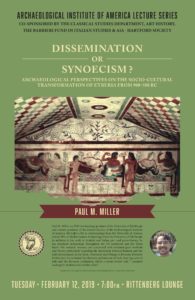 |
|
| September 13, 2018
Ashes, Ashes, They all Fell Down:A New Theory About the Destruction of the Mycenaean Palace of Nestor Julie Hruby, Dartmouth College Co-sponsored by the Program in Environmental Science
|
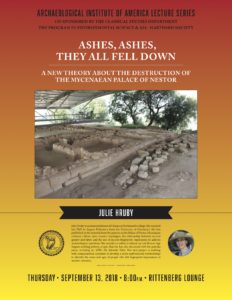 |
|
| October 26, 2017
Dionysos & Vesuvius in the Villa of the Mysteries Karen Polinger Foster, Yale University
|
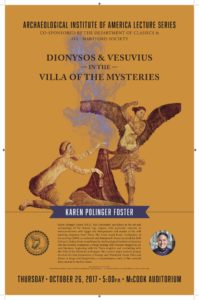 |
|
| October 21 & 22, 2016
Archaeology Conference in Honor of Betsy Gebhard Co-sponsored by the Trinity Institute for Interdisciplinary Studies (TIIS) |
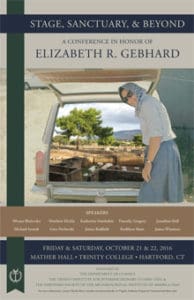 |
|
| October 3, 2016
At the Still Point of the Turning World: Landscape and Ideology in Chaco Canyon, New Mexico Ruth Van Dyke, SUNY Binghamton University
|
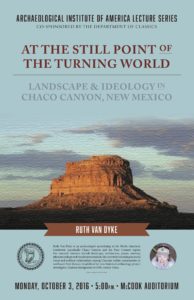 |
|
| September 19, 2016
Columbus and Cannibals in the Land of Cotton William Keegan, Florida Museum of Natural History Co-sponsored by Department of History, Program in Human Rights, and the Program in Caribbean Studies
|
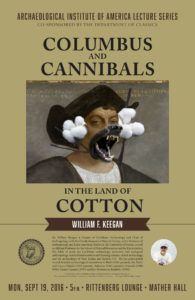 |
|
| April 11, 2016 Preserving the Present, Repurposing the Past: Tradition, Politics, and Funereal Magic in Christian Anglo-Saxon England Alexandra Aversa Sheldon |
||
| April 4, 2016 Stars Sparkling on the Waters: The Temple of Baal ‘Addir/ Poseidon at Motya and the History of the Mediterranean Lorenzo Nigro – La Sapienza University |
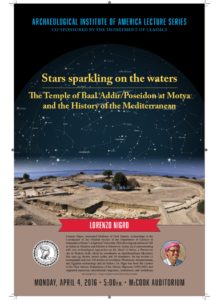 |
|
